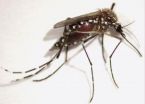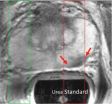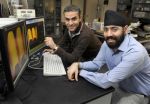(Press-News.org) Rice University researchers have discovered a simple way to make carbon nanotubes shine brighter.
The Rice lab of researcher Bruce Weisman, a pioneer in nanotube spectroscopy, found that adding tiny amounts of ozone to batches of single-walled carbon nanotubes and exposing them to light decorates all the nanotubes with oxygen atoms and systematically changes their near-infrared fluorescence.
Chemical reactions on nanotube surfaces generally kill their limited natural fluorescence, Weisman said. But the new process actually enhances the intensity and shifts the wavelength.
He expects the breakthrough, reported online in the journal Science, to expand opportunities for biological and material uses of nanotubes, from the ability to track them in single cells to novel lasers.
Best of all, the process of making these bright nanotubes is incredibly easy -- "simple enough for a physical chemist to do," said Weisman, a physical chemist himself.
He and primary author Saunab Ghosh, a graduate student in his lab, discovered that a light touch was key. "We're not the first people to study the effects of ozone reacting with nanotubes," Weisman said. "That's been done for a number of years.
"But all the prior researchers used a heavy hand, with a lot of ozone exposure. When you do that, you destroy the favorable optical characteristics of the nanotube. It basically turns off the fluorescence. In our work we only add about one oxygen atom for 2,000-3,000 carbon atoms, a very tiny fraction."
Ghosh and Weisman started with a suspension of nanotubes in water and added small amounts of gaseous or dissolved ozone. Then they exposed the sample to light. Even light from a plain desk lamp would do, they reported.
Most sections of the doped nanotubes remain pristine and absorb infrared light normally, forming excitons, quasiparticles that tend to hop back and forth along the tube -- until they encounter oxygen.
"An exciton can explore tens of thousands of carbon atoms during its lifetime," Weisman said. "The idea is that it can hop around enough to find one of these doping sites, and when it does, it tends to stay there, because it's energetically stable. It becomes trapped and emits light at a longer (red-shifted) wavelength.
"Essentially, most of the nanotube is turning into an antenna that absorbs light energy and funnels it to the doping site. We can make nanotubes in which 80 to 90 percent of the emission comes from doped sites," he said.
Lab tests found the doped nanotubes' fluorescent properties to be stable for months.
Weisman said treated nanotubes could be detected without using visible light. "Why does that matter? In biological detection, any time you excite at visible wavelengths, there's a little bit of background emission from the cells and from the tissues. By exciting instead in the infrared, we get rid of that problem," he said.
The researchers tested their ability to view doped nanotubes in a biological environment by adding them to cultures of human uterine adenocarcinoma cells. Later, images of the cells excited in the near-infrared showed single nanotubes shining brightly, whereas the same sample excited with visible light displayed a background haze that made the tubes much more difficult to spot.
His lab is refining the process of doping nanotubes, and Weisman has no doubt about their research potential. "There are many interesting scientific avenues to pursue," he said. "And if you want to see a single tube inside a cell, this is the best way to do it. The doped tubes can also be used for biodistribution studies.
"The nice thing is, this isn't an expensive or elaborate process," Weisman said. "Some reactions require days of work in the lab and transform only a small fraction of your starting material. But with this process, you can convert an entire nanotube sample very quickly."
###
The paper's co-authors include Rice research scientist Sergei Bachilo, research technician Rebecca Simonette and Kathleen Beckingham, a Rice professor of biochemistry and cell biology.
The National Science Foundation, the Welch Foundation and NASA supported the research.
Read the abstract at http://www.sciencemag.org/content/early/2010/11/24/science.1196382.abstract
An animation is available at http://www.youtube.com/watch?v=Dg3xQVSrryY
Artwork is available for download at http://www.media.rice.edu/images/media/NEWSRELS/1201_Weisman.jpg
CAPTION:
Single-walled carbon nanotubes treated with ozone incorporate oxygen atoms that shift and intensify the nanotubes' near-infrared fluorescence emission. The discovery by Rice University scientists should lead to new uses of nanotubes in biomedicine and materials science. (Credit: Bruce Weisman/Rice University)
Located in Houston, Rice University is consistently ranked one of America's best teaching and research universities. Known for its "unconventional wisdom," Rice is distinguished by its: size -- 3,279 undergraduates and 2,277 graduate students; selectivity -- 12 applicants for each place in the freshman class; resources -- an undergraduate student-to-faculty ratio of 5-to-1; sixth largest endowment per student among American private research universities; residential college system, which builds communities that are both close-knit and diverse; and collaborative culture, which crosses disciplines, integrates teaching and research, and intermingles undergraduate and graduate work.
END
LIVERMORE, Calif. - Arsenic - an element that triggers death for most Earthly life forms - is actually allowing for a bacterium to thrive and reproduce.
In a study that may prompt the rewriting of textbooks, a team of astrobiologists and chemists has found the first known living organism that can use arsenic in place of phosphorus in its major macromolecules. The new findings, published in the Dec. 2 Science Express, could redefine origins of life research and alter the way we describe life as we know it.
Oxygen, carbon, hydrogen, nitrogen, sulfur and phosphorous ...
RIVERSIDE, Calif. – Each year, dengue fever infects as many as 100 million people while yellow fever is responsible for about 30,000 deaths worldwide. Both diseases are spread by infected female Aedes aegypti mosquitoes, which require vertebrate blood to produce eggs. The blood feeding and the egg development are tightly linked to how the mosquito transmits the disease-causing virus.
Now a team of entomologists at the University of California, Riverside has identified a microRNA (a short ribonucleic acid molecule) in female Aedes aegypti mosquitoes that when deactivated ...
Raw milk is consumed by an estimated 1-3 percent of the United States population. Raw milk and raw cheeses are responsible for almost 70 percent of reported dairy outbreaks. On July 16, 2008, the Connecticut Department of Public Health identified two unrelated children who had experienced hemolytic uremic syndrome after consuming raw milk from the same farm. The authors investigated the situation further and found more cases of people affected by raw milk from the same farm. The details of their study are chronicled in the Dec. 15 issue of Clinical Infectious Diseases, ...
A fast test to diagnose fatal brain conditions such as mad cow disease in cattle and Creutzfeldt-Jakob disease in humans could be on the horizon, according to a new study from National Institutes of Health scientists. Researchers at NIH's National Institute of Allergy and Infectious Diseases (NIAID) have developed a highly sensitive and rapid new method to detect and measure infectious agents called prions that cause these diseases.
"Although relatively rare in humans and other animals, prion diseases are devastating to those infected and can have huge economic impacts," ...
The research was led by Dr. Matthew Ellinwood, a veterinarian and animal science professor at Iowa State University, in collaboration with Dr. Patricia Dickson at the Harbor-UCLA Medical Center, with colleagues at the Iowa State College of Veterinary Medicine, the University of Tennessee, St. Louis University and the University of Pennsylvania. Their work was published in the AAAS journal Science Translational Medicine.
The research focused on a disorder called mucopolysaccharidosis type I, or MPS I, which is caused by the lack of a key enzyme that breaks down substances ...
November 30, 2010 -- Despite the existence of effective programs for treating alcohol dependencies and disorders, less than a quarter of people who are diagnosed actually seek treatment. In a recent study by Columbia University's Mailman School of Public Health researchers report that people diagnosed with alcoholism at some point in their lifetime were more than 60% less likely to seek treatment if they believed they would be stigmatized once their status is known.
This is the first study to address the underuse of alcohol services specifically with regard to alcohol-related ...
###
Gold, L., et al. (2010). “Aptamer-based multiplexed proteomic technology for biomarker discovery,” PLoS One. Available online at http://dx.plos.org/10.1371/journal.pone.0015004
Ostroff, R. et al. (2010). “Unlocking biomarker discovery: Large scale application of aptamer proteomic technology for early detection of lung cancer.” PLoS One. Available online at http://dx.plos.org/10.1371/journal.pone.0015003
About SomaLogic, Inc.
SomaLogic, Inc., is a privately held biomarker discovery and clinical proteomics company based in Boulder, Colorado. The company's mission ...
A UCSF research collaboration with GE Healthcare has produced the first results in humans of a new technology that promises to rapidly assess the presence and aggressiveness of prostate tumors in real time, by imaging the tumor's metabolism.
This is the first time researchers have used this technology to conduct real-time metabolic imaging in human patients and represents a revolutionary approach to assessing the precise outlines of a tumor, its response to treatment and how quickly it is growing.
Data on the first four patients are being presented today at the Radiology ...
AMES, Iowa – Researchers from Iowa State University and the Ames Laboratory have developed a process capable of producing a thin and uniform light-absorbing layer on textured substrates that improves the efficiency of polymer solar cells by increasing light absorption.
"Our technology efficiently utilizes the light trapping scheme," said Sumit Chaudhary, an Iowa State assistant professor of electrical and computer engineering and an associate of the U.S. Department of Energy's Ames Laboratory. "And so solar cell efficiency improved by 20 percent."
Details of the fabrication ...
(Santa Barbara, Calif.) –– A ballet dancer grasps her partner's hand to connect for a pas de deux. Later that night, in the dark, she reaches for her calf to massage a sore spot. Her brain is using different "maps" to plan for each of these movements, according to a new study at UC Santa Barbara.
In preparing for each of these reaching movements, the same part of the dancer's brain is activated, but it uses a different map to specify the action, according to the research. Planning to hold hands is based on her visual map of space. Her second plan, to reach for her calf, ...


